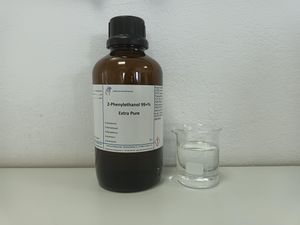Phenethyl alcohol
 Phenethyl alcohol bottle and sample.
| |
| Names | |
|---|---|
| IUPAC name
2-Phenylethanol
| |
| Preferred IUPAC name
2-Phenylethan-1-ol | |
| Other names
2-Phenylethanol
Benzeneethanol Benzyl carbinol PEA Phenethyl alcohol Phenyl-2-ethanol β-Hydroxyethylbenzene | |
| Properties | |
| C8H10O C6H5CH2CH2OH | |
| Molar mass | 122.16 g/mol |
| Appearance | Colorless viscous liquid |
| Odor | Soft, floral |
| Density | 1.017 g/cm3 (20 °C) |
| Melting point | −27 °C (−17 °F; 246 K) |
| Boiling point | 218.2 °C (424.8 °F; 491.3 K) |
| 2.22 g/100 ml (25 °C) | |
| Solubility | Miscible with acetone, alcohols, chloroform, diethyl ether, glycerol, propylene glycol Slightly miscible in mineral oil |
| Vapor pressure | 0.09 mmHg (25 °C) |
| Hazards | |
| Safety data sheet | Sigma-Aldrich |
| Flash point | 102 °C (215.6 °F; 305 K) |
| Related compounds | |
| Related compounds
|
Benzyl alcohol |
| Except where otherwise noted, data are given for materials in their standard state (at 25 °C [77 °F], 100 kPa). | |
| Infobox references | |
Phenethyl alcohol or 2-phenylethanol, is an organic compound with the formula C8H10O.
Contents
Properties
Chemical
Oxidation of phenethyl alcohol yields phenylacetic acid.
Physical
Phenethyl alcohol is a colorless liquid, immiscible with water, but miscible with many organic solvents. Its odor has been described as "floral" or "rose-like", though some claim it smells closer to crushed plant seeds, while having a honey-like scent at high concentration. This may also depend on the purity of the reagent.
Availability
Phenethyl alcohol is sold by chemical suppliers.
It occurs widely in nature, being found in a variety of essential oils.
Preparation
Phenethyl alcohol can also be prepared by the Grignard reaction between phenylmagnesium bromide and ethylene oxide:
- C6H5MgBr + CH2CH2O → C6H5CH2CH2OMgBr
- C6H5CH2CH2OMgBr + H+ → C6H5CH2CH2OH
Industrially 2-phenylethanol is prepared via the Friedel-Crafts reaction between benzene and ethylene oxide in the presence of anhydrous aluminium chloride.
- C6H6 + CH2CH2O + AlCl3 → C6H5CH2CH2OAlCl2 + HCl
The reaction affords the aluminium alkoxide that is subsequently hydrolyzed to the desired product.
- C6H5CH2CH2OAlCl2 + H2O → C6H5CH2CH2OH + AlCl2(OH)
According to one source, it is also possible to produce phenethyl alcohol by the reduction of phenylacetic acid using sodium borohydride and iodine in THF.[1]
Projects
- Make perfumes
- Make phenethyl esters
- Make phenylacetic acid
Handling
Safety
Phenethyl alcohol has low toxicity and it's a safe component of perfumes and aromas.
Storage
Phenyl ethanol should be kept in dark amber glass bottles. Prolonged contact with air will cause it to turn slightly yellowish, but this usually does not affect its purity.
Disposal
No special disposal is required.
References
- ↑ Kanth JV, Periasamy M (1991). "Selective Reduction of Carboxylic Acids into Alcohols Using NaBH and I2". Journal of Organic Chemistry. 56: 5964–5965